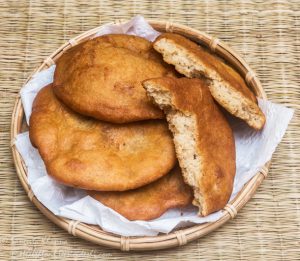Gur te Ajwain da Wadda (Molasses Carom Seeds Patty)
In North India, every child knows the joy of eating gajjak (a soft molasses swirl) or ravri (hard molasses pellets) especially during the winter months when these are plentiful. You can find villagers who come to the city for a few weeks with their bags of gur (jaggery or sugarcane juice rock molasses) and set up stalls where they make gur sweets, popular in the cold season. And then just as quickly, they are gone! Gur then takes its place on the back shelves waiting for winter to arrive again.
Unfortunately, most of the Indian children growing up in the US have no idea what gur and gur based sweets are all about. They don’t realize the beneficial, energy giving qualities that gur has.
Gur is the solid brown, unrefined, coalesced natural product of boiling sugar cane juice in round bottom vats till it is dry. It is a brown raw mass made of upto 50% sucrose, 20% invert sugars and 20% moisture with the remainder made up of other insoluble matter, such as wood ash, proteins, and bagasse fibers from which it gets its color. Bagasse is the dry pulpy residue that remains after sugarcane stalks are crushed to extract their juice.
Gur provides many health benefits like preventing constipation; detoxing the liver; providing antioxidants and minerals like zinc and selenium; relieve PMS symptoms in women and act as a natural sweetener. But because it is high in calories, it must be taken in moderation especially by diabetics. It is good for the heart, purifies the blood, prevents anemia and asthma and strengthens the immunity levels.
It can help in treating a cold or cough and relieve bone and joint pains, which is what this recipe is good for. This is an age old recipe which has been in my family for generations. It combines the benefits of gur with that of ajwain (carom seeds) and moderates the bitter taste. When eaten hot, it can help relive the discomfort of minor pains and illnesses.
Ingredients:
• 2 tbsp gur (jaggery or sugarcane rock molasses)
• 1 tsp ajwain (carom seeds)
• ½ tsp saunth (powdered dry ginger)
• 4 tsp badam (almonds)
• 1 tbsp ghee (clarified butter)
Directions:
1. Smash the almonds into small pieces, but do not crush them. Likewise, break the gur into smaller pieces.
2. Place a small frying pan over medium heat and when it is nice and hot, throw in the ghee and let it melt.
3. Now, add the ajwain and stir. Then add the saunth and smashed badam. Stir till the badam are a little brown.
4. When the badam are brown, add the gur pieces, turn off the heat and let it melt while stirring.
5. Place on a plate to cool off and then serve.
MAMA’S TIP OF THE WEEK: HEAT GUR (MOLASSES) CAREFULLY TO MAKE SWEET SNACKS
Gur or sugarcane rock molasses is a favorite all across North India during the winter months as it is consumed for the energy it provides in fighting the cold. From December to March, you can find the bazaars full of sweet snacks made with gur and gajjak (soft shelled swirls) and ravri (hard coated pellets) selling by the gram. If you ask the stall vendor, they’ll even warm them on a small coal-burner.
But for those who aren’t familiar with cooking with gur, be careful of how hot it gets when melted and how it takes long to cool down. You don’t want to burn your palate on the first spoonful. And also, if you overcook the gur, instead of a melted patty, you’ll end up with a crispy cookie that is called ravri!

Shakuntla Malhotra is a skilled cook of Punjabi dishes made in the old-fashioned style that she learnt as a young woman in her ancestral home in Lyallpur, India (since renamed Faisalabad) before it became part of Pakistan after the Partition in 1947. People have often admired her cooking for its simplicity and taste that comes with each mouthful. Even in her late-eighties, she continues to cook daily and agreed to share her delectable Punjabi vegetarian recipes for future generations.

